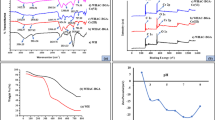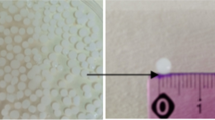Abstract
Carcinogenic heavy metal chromium, in its hexavalent form Cr(VI) is spuriously used in various industrial operations because of its hardness and stability. Due to lack of proper remediation processes, effluents contain Cr(VI) in large excess of WHO’s statutory limit of 50 μg l−1. In this study, a biosorption-based remediation strategy is proposed for the remediation of Cr(VI) from contaminated samples. The novel bacterial strain Enterobacter aerogenes T2 (GU265554, NII 1111) was isolated from Cr(VI)-contaminated tannery effluent and used for bioremediation studies. The cell-free extract (CFE) was prepared and encapsulated in spherical calcium alginate biopolymeric beads. A semi-batch plug-flow-packed bed made of these beads was used for biosorption of Cr(VI). A remediation rate of 932 mg Cr(VI) m−3 water per day with a sorption efficiency of 93.2 % was achieved. The method exhibited the best results when compared to those reported in the literature. Various isotherm models of adsorption such as Langmuir, Freundlich, and Dubinin-Radushkevich (D-R) were studied. The results predicted adsorption in a multi-layered fashion via physisorption. The developed technology could be considered as green since no synthetic chemical was used for sorption of Cr(VI).










Similar content being viewed by others
References
Agrawal, P., & Bajpai, A. K. (2011). Biosorption of chromium (VI) ions from aqueous solutions by iron oxide-impregnated alginate nanocomposites: batch and column studies. Toxicological and Environmental Chemistry, 1277–1297.
Bera, D., Chattopadhyay, P., & Ray, L. (2006). Chromium VI biosorption by immobilized biomass of Bacillus cereus M1 16. Journal of Hazardous Substance Research, 6(2), 1–23.
Beveridge, T., McLean, J., & Phipps, D. (2000). Isolation and characterization of a chromium-reducing bacterium from chromate copper arsenate-contaminated site. Environmental Microbiology, 2, 611–619.
Boddu, V. M., Abburi, K., Talbott, J. L., & Smith, E. D. (2003). Removal of hexavalent chromium from wastewater using a new composite chitosan biosorbent. Environmental Science and Technology, 37, 4449–4456.
Chauhan, G. S., & Kumara, M. (2011). Adsorption capacity, kinetics and mechanism of copper II gelatin-based hydrogels. Journal of Applied Polymer Science, 119(1), 363–370.
Fiol, N., Escudero, C., Poch, J., & Villaescusa, I. (2006). Preliminary studies on Cr(VI) removal from aqueous solution using grape stalk wastes encapsulated in calcium alginate beads in a packed bed up-flow column. Reactive and Functional Polymer, 66, 795–807.
Hena, S. (2010). Removal of chromium hexavalent ion from aqueous solutions using biopolymer chitosan coated with poly 3-methyl thiophene polymer. Journal of Hazardous Materials, 181(3), 474–9.
Jeyasingh, J., & Philip, L. (2005). Bioremediation of chromium contaminated soil: optimization of operating parameters under laboratory conditions. Journal of Hazardous Materials, 118, 113–120.
Kumar, A. S. K., Rajesh, N., Kalidhasan, S., & Rajesh, V. (2011). An enhanced adsorption methodology for the detoxification of chromium using n-octylamine impregnated Amberlite XAD-4 polymeric sorbent. Journal of Environmental Science and Health, Part A, 46, 1596–1610.
Mishra, S., & Doble, M. (2008). Novel chromium tolerant microorganisms: isolation, characterization and their biosorption capacity. Ecotoxicology and Environemntal Safety, 71, 874–879.
Neil, Q., Wofford, P., Beaty, S., & McInerney, M. J. (1986). Preparation of cell-free extracts and the enzymes involved in fatty acid metabolism in Syntrophomonas wolfei. Journal of Bacteriology, 167, 179–185.
Pal, A., Dutta, S., & Paul, A. K. (2005). Reduction of hexavalent chromium by cell-free extract of Bacillus spaericus AND 303 isolated from serpentine soil. Current Microbiology, 51, 327–330.
Panda, J., & Sarkar, P. (2012a). Bioremediation of chromium by novel strains Enterobacter aerogenes T2 and Acinetobacter sp. PD12 S2. Environmental Science and Pollution Research, 19, 1809–1817.
Panda, J., & Sarkar, P. (2012b). Isolation, identification, characterization and field application of Cr(VI) resistant bacteria. Journal of Environmental Science and Health, Part A, 47, 237–244.
Panda, J., & Sarkar, P. (2014). Biosensing and bioremediation of Cr(VI) by cell free extract of Enterobacter aerogenes T2. Journal of Environmental Science and Health, Part A, 49, 600–608.
Ramakrishna, K., & Phillip, L. (2005). Bioremediation of Cr(VI) in contaminated soils. Journal of Hazardous Materials, 121, 109–117.
Rodriguez, M. G., & Martinez, S. A. (2005). Removal of Cr(VI) from wastewaters in a tubular electrochemical reactor. Journal of Environmental Science and Health, Part A, 40, 2215–2225.
Sambrook, J., & Russel, D. W. (2001). Molecular cloning: a laboratory manual. New York: CSHL Press.
Shakoori, A. R., Makhdoom, M., & Haq, R. U. (2000). Hexavalent chromium reduction by dichromate resistant gram-positive bacterium isolated from effluents of tanneries. Applied Microbiology and Biotechnology, 53(3), 348–451.
Srinath, T., Verma, T., Ramteke, P. W., & Garg, S. K. (2002). Chromium VI biosorption and bioaccumulation by chromate resistance bacteria. Chemosphere, 48, 427–435.
Standard Methods for the Examination of Water and Wastewater. (1989). Washington DC. American Public Health Association (APHA).
Tuprakay, S., & Liengcharernsit, W. (2005). Lifetime and regeneration of immobilized titania for photocatalytic removal of aqueous hexavalent chromium. Journal of Hazardous Materials, 53–58.
Vilar, R., & Coloco, R. (2003). A model for the abrasive wear of metallic matrix article-reinforced materials. Wear, 254, 625–634.
Acknowledgments
The author JP gratefully acknowledges fellowships provided by the University Grants Commission (UGC), and Council of Scientific and Industrial Research (CSIR), India. The author PS acknowledges research funds from the UGC and CSIR.
Author information
Authors and Affiliations
Corresponding author
Rights and permissions
About this article
Cite this article
Panda, J., Sarkar, P. Biosorption of Cr(VI) by Calcium Alginate-Encapsulated Enterobacter aerogenes T2, in a Semi-Batch Plug Flow Process. Water Air Soil Pollut 226, 2157 (2015). https://doi.org/10.1007/s11270-014-2157-9
Received:
Accepted:
Published:
DOI: https://doi.org/10.1007/s11270-014-2157-9




